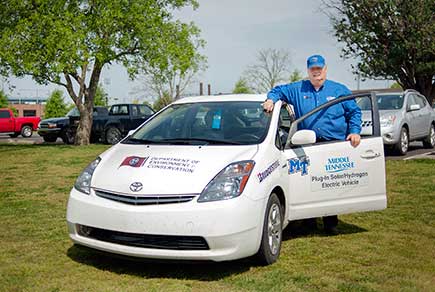Running vehicles off solar energy and hydrogen produced from water could be a solution to the world's energy problems.
MTSU started working on alternative fuel projects in 1979. The work was spurred by the fact that the Iranians had taken hostages and OPEC was attempting to control the world's petroleum supply. Out of frustration, the author and his students started the conquest for the American farmer to be energy independent in the time of global crisis.
Running an engine off corn (ethanol) was the first challenge. Although many other people were doing similar research with ethanol, it was the persistence of the MTSU team that eventually led to building and running an ethanol-powered truck that ran over 25,000 miles on pure ethanol. Presentations were made at the 1982 World's Fair and Tennessee Valley Authority's (TVA) 50th Anniversary Barge Tours.
Having accomplished all the goals in ethanol production, the next challenge was to run an engine off cow manure (methane). Once hydrogen sulfide and carbon dioxide are removed, the gas that remains is CH4 (natural gas). Natural gas engines were fairly common, and several engines were observed that ran off methane. It was found that methane production was viable and methane digesters were in selected large dairy farms. The knowledge gained in the study of methane production led to the ultimate challenge: to run an engine off hydrogen from water. The MTSU team in 1987 ran an eight-horsepower engine off hydrogen from water for eight seconds one day and two minutes the next.
Since then the author and his students have run tractors, cars, trucks, and stationary engines off hydrogen. The researchers were invited to the world's first hydrogen race at the 1991 Bonneville speed trials at the Great Salt Flats in Wendover, Utah, where they set the world's land-speed record for hydrogen. MTSU researchers proceeded to build another engine that ran off pure hydrogen, entered the vehicle in the Southern California Timing Association world finals in 1992 at the Bonneville Salt Flats, and set a new world land speed record for a pure hydrogen-fueled vehicle, which they held for 15 years.
Problem
Gasoline is continuing to rise with prices exceeding $ 3.55 per gallon for the lowest octane in Tennessee. In Canada and Europe, prices exceed $5 per gallon. Furthermore, petroleum-based fuels emit hydrocarbons, which many believe contribute to the greenhouse effect.
The U.S. is extremely dependent on imported oil. About 41 percent of oil consumed in the U.S. is imported from its trading partners, representing the single most important contributor to the national balance-of-trade deficit. The transportation industry uses about 64 percent of the oil consumed in the U.S.
Hydrogen is considered an alternative candidate for revitalizing renewable primary energy sources because of its compatibility with any type of source as well as its negligible ecological impact and also because these advantages are matched by a rather high efficiency in energy conversion and storage. Burning hydrogen in internal-combustion engines will reduce the need for imported oil, the trade deficit, and pollution in urban areas, and it has implications for world peace.
Purpose
The purpose of this project is to develop a system so that vehicles can run off sun and hydrogen from water, including the installation of a solar photovoltaic system to power a hydrogen solid polymer electrolysis unit, the installation of compressors and storage tanks, and the development of vehicles to run off hydrogen. The complete system will be a demonstration site to show how every commuter in the country could drive to work using only sun and hydrogen from water as fuel.
 Cliff Ricketts, who spearheads MTSU alternative fuel projects, shows off his modified Prius. Cliff Ricketts, who spearheads MTSU alternative fuel projects, shows off his modified Prius.
Objectives
1. Install 10-kilowatt solar unit using TVA Green Power Providers program.
Big Frog Mountain Energy installed the unit. The electricity produced by the solar array goes into the Murfreesboro electric grid lines within TVA. All electricity produced is monitored with automatic computer readings and calculations. Since the unit was started in 2004, over 102,000 kw have been produced. The energy is stored in a bank for use any time, day or night, sunny or cloudy. When electricity is used to run the electrolysis unit, another meter counts kilowatts used. When electricity is taken from the bank, an immediate balance is available (input minus output). The current kilowatt balance is over 75,000.
2. Install a Proton Energy Hogen 40 electrolysis unit.
Murfreesboro water district tap water goes through a water de-ionizer unit to remove all elements except hydrogen and oxygen before it goes into the electrolysis unit. The Hogen 40 separates the hydrogen and oxygen from water. The oxygen is vented into the atmosphere. The hydrogen comes out at 200 pounds of pressure.
3. Install two 500-gallon propane tanks for temporary hydrogen storage at 200 PSI to provide extra, cheap storage for quicker refueling.
4. Install 5,000 PSI compressor to store hydrogen long-term.
Two regular shop compressors were used to run the 5,000 PSI compressor faster.
5. Install 16 K-cylinders with high-pressure gauge to store hydrogen and fill vehicle.
Each holds 6,500 PSI of hydrogen with appropriate safety valves and rings. Sixteen tanks were needed to fill the Tercel with its two 4.2-kilogram, carbon-wrapped 5,000 PSI tanks from Dynetek. Using the cascading system, each tank is opened until the pressure in the vehicle is equalized, with one external valve opened to fuel the vehicle. Optimum pressure could not be obtained.
6. Convert Nissan 24 KE three-valve internal combustion engine to run on hydrogen.
This was done before the Hogen 40 unit was installed, so commercial hydrogen was used for this vehicle.
7. Build and adapt a solar/electric/hydrogen hybrid car to run on sun and hydrogen from water (same concept as the Chevy Volt).
A Chevy Blazer was purchased and the engine removed. A 22-horsepower Diatshu engine/generator that originally ran off gasoline was purchased, converted to run off hydrogen, and installed into the car body. A 100-horsepower electric motor was installed to an adapter plate attached to the transmission bellhousing. The car has a range of 50 miles off solar electric and 200 miles off hydrogen from water, fueled by the system described in the first five objectives.
8. Adapt a Toyota Prius to run off solar/electric, solar/hydrogen, and ethanol plus still run on gasoline.
A simple electronic device was added to adapt the engine to run on ethanol. The hydrogen conversion included installation of a Dynetek 4.2-kilogram tank, selected pressure gauges and lines, a hydrogen fuel rail and hydrogen injectors, and an AEM computer-timing system. Plug-In Supply of California installed a 10-kilowatt battery pack of lithium iron phosphate batteries to give the Prius a 50-mile range off solar electric and later a second one to boost the range to 100 miles. Ethanol and gasoline used the same fuel tank. The vehicle has a 700-mile range on the three alternative fuels. For daily driving, solar/electric and solar/hydrogen are used.
9. Convert a 1994 Toyota Tercel, chosen for its 44 mpg range, to run on hydrogen.
A Honda distributor replaced the Tercel distributor to match the AEM computer-timing system that was installed. Two 4.2-kilogram, 5,000 PSI hydrogen Dynetek tanks were installed with appropriate gauges and fuel lines, using a specially built hydrogen fuel rail and hydrogen injectors. The car was timed in each gear, and its range is 370-400 miles before refueling with hydrogen.
10. Demonstrate a solar water refinery system using the Hogen 40 compressor storage system yo show that commuters could drive daily off sun and hydrogen from water.
To make the filling quicker for more vehicles, an additional compressor was added with a large storage system.
11. Drive across Tennessee in one day (about 500 miles) on only sun and hydrogen from water, using the Hogen 40 to produce hydrogen.
12. Drive coast to coast on 2.15 gallons of gas using the Hogen 40 to produce hydrogen for part of the trip.
A third of the trip, 900 miles, was driven with sun and hydrogen from water (New Tybee Beach, east of Savannah, Georgia, to Conway, Arkansas). Then the team drove on 95 percent ethanol and 5 percent gasoline to Long Beach, California, about 1,700 miles. No gasoline was needed, but the law requires at least a five percent mixture. Forty-three gallons of E-95 were used, resulting in only 2.15 gallons of gasoline.
13. Drive coast to coast on only sun and hydrogen from water.
Tanks were secured for mobile storage. In March 2013 the Tercel was driven from New Tybee Beach, Georgia, to about 50 miles north of Atlanta. A hydrogen Toyota Prius purchased from a completed wind/hydrogen research project in Vermont was driven to MTSU for refueling. The next day, the Tercel and Prius were driven to Fort Smith, Arkansas. The cars were refueled with 3,500 PSI tanks (from Lincoln Composites in Lincoln, Nebraska) on a trailer pulled by a van, which got the team to Santa Rosa, New Mexico. Due to the tanks' lower pressure, two fueling stops were made along the way. On the fourth and fifth days, the Tercel and Prius were fueled with 5,000 PSI tanks from Dynetek in Calgary, Canada, to get the team to Long Beach, California. The tanks, 10 feet long and 18 inches in diameter, were hauled on a Ford 150 pick-up truck, properly secured. Objective eight's Toyota Prius was a back-up vehicle.
14. Develop a concept for a group of people to buy a solar system and Hogen 40 or larger electrolysis unit to run their vehicles cost efficiently off sun and hydrogen from water.
Proton Energy has a system called "neighbor fueling." MTSU's system cost $150,000 for a 10-kilowatt solar unit, an electrolysis unit, a compressor, and storage tanks. If seven families partnered, each would pay $21,428. Recent news revealed the average family spends $400 a month on fuel, which would mean a 53-month payoff. In the Green Power Providers program, MTSU pays .08 cents for each kilowatt used, but TVA pays 20 cents per kilowatt produced. Using the system makes money.
15. Develop a concept for counties or cities to buy a solar unit and a large proton energy electrolysis unit to run cars off sun and hydrogen.
Another option is mini-nuclear: nuclear power plants small enough to be transported by truck, rail, or ship, conceived at Los Alamos National Lab in New Mexico and developed by Hyperion Power Generation, are available for about $25 million. They are safe, need refueling only every seven to 10 years, and produce enough energy to power 10,000-20,000 homes at 10 cents a kilowatt. Add five Proton Energy C-30 electrolysis units, and the cost is that of building a new school.
Proton Energy has a system called centralized fueling. If the electrolysis unit and mini-nuclear plant cost $28.3 million and power 20,000 homes, the cost is $1,400 per household. This system would also provide enough fuel for about 700 cars averaging one fill-up a week. Each state could develop a motor pool demonstration site to promote the technology's use for state vehicles: $28 million would be a small budget item for any state.
16. Publicize work. Credit TVA, Tractor Supply Company, and MTSU Office of Research Services.
The coast-to-coast trip on 2.15 gallons of gas got over 40,000 hits on Google and coverage by ABC News, Yahoo News, about 10 TV stations nationwide including CBS, USA Today, and several hundred other publications.
* Cliff Ricketts is a professor of agricultural education and alternative fuel at MTSU. |
 |


[See lecture video.]
Burning hydrogen in internal combustion engines will reduce the need for imported oil, the trade deficit, and pollution in urban areas, and it has implications for world peace.
The complete system will be a demonstration site to show how every commuter in the country could drive to work daily off sun and hydrogen from water as the only energy source.
|
 Cliff Ricketts, who spearheads MTSU alternative fuel projects, shows off his modified Prius.
Cliff Ricketts, who spearheads MTSU alternative fuel projects, shows off his modified Prius.

